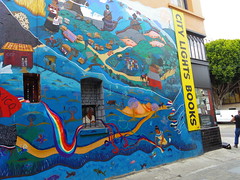During March, I plunged into reading, tackling some two serious reads as part of several challenges on LibraryThing. I blogged about the idea of reading challenges on my education blog. “Gamifying” reading can be a way to expand your reading options or, in my case, dig into some of the many books I have purchased and never read. There are lots of books on the shelves these days.
Here’s the list. I’ve marked the challenge books:
Team of Rivals and All the King’s Men were both long, serious books, but also incredibly engaging. Well written narratives with, whether fiction or non, compelling characters who show the full range of human emotion, inspiration and ambition. I filled in with more light reads although Grasshopper Jungle, a dystopian, end-of-the-world young adult book, managed to provide some real insight into the teen heart and mind within its dark comedic tone.
By the end of the month, however, I realized I wasn’t going to be able to finish the last challenge book I had planned for the month. A Soldier of the Great War by Mark Helprin met the challenge of being about someone who was part of WW I but was much longer than I thought. I’m old school that way: I judge a book by its girth in the physical world. I haven’t gotten used to judging it by its dots. I dove in with just two days until the end of the month and enjoyed what I read but then stalled out when it became clear that I was not going to meet the challenge. I’ll get back to it but for now with Spring luring me into the garden, I just don’t have time to dig in the way I need to for such a tome.
Since I try not to bring screens to bed, I needed an analog book to read. In the spirit of World War I and feeling a little guilty about Helprin, I picked up The First World War by John Keegan. I bought this book after reading Ken Follett’s The Fall of Giants, thinking I wanted to know more about WW I. While the content was interesting and the book was well written, it had small print, lots of names, too many details for me to really enjoy it. I’m still not sure I know how the war started except that the nations had all geared up for war so any excuse would have probably led to the disaster. I really felt like I needed an atlas, a primer in pre-WW I nations and a “who’s who” list. I may get back to it some day but for now, it’s way MORE than I want to know.
Fortunately, I was saved by a trip to the Green Valley Book Fair near Harrisonburg, Virginia. My trip yielded a small pile of books, and I started reading The Heart of Everything That Is, a biography of Red Cloud, in the hotel room that evening. It was an engaging, sometimes irreverent history, unbiased in its brutally honest depictions of both white and Native Americans. I finished it quickly and then discovered I didn’t have the energy to go back to the two WW I books that were waiting.
So, prompted by a drive across the state that went through Prince Edward County, I picked up Israel on the Appomattox, the story of a community of freed blacks created near Farmville. It’s been on the shelf for some time now. So, I’m one chapter in and just mired in the small print, lots of names and too many details.
I love history and historical fiction so what’s the problem? Why the Red Cloud bio but not the WW I history? The purpose of the text seems to be the difference for me. The biography included historical details, but the primary focus of the book was to tell the story. Not every thread was pursued, not every moment of every event filled in. We didn’t get a long bio of every person mentioned but followed a few important figures. And, I didn’t have a sense that there was going to be a test at the end. In the end, I probably remember more of the details that were included in The Heart of Everything That Is (because there weren’t quite so many of them), and I have a good general sense of what happened in the mid-19th century American west.
I may be ready for WW I and Prince Edward County at some point in the future, but not right now…my free reading time is often limited to before bed, and small print, lots of names and too many details are not really appealing. I feel like I am completing required reading rather than really enjoying myself. I want a light but interesting story that is engaging but not overwhelming. Maybe I’ll try WW I from a different angle. At the book fair, I found Elsie & Mairi Go to War by Diane Atkinson. It’s the true life story of two women who worked as ambulance drivers during the great war. It’s got a welcoming cover, a decently sized font, and the first prologue is immediately engaging:
Eighteen-year-old Mairi and thirty-year-old Elise Knocker, divorcee and mother of a young son, were madcap motorbikers who had met while roaring around the Hampshire and Dorset lanes, and had competed in motorbike and sidecar trials for the last year.
Here’s history wrapped in a story with the kind of compelling characters that made Team of Rivals and All the King’s Men such riveting reads.












